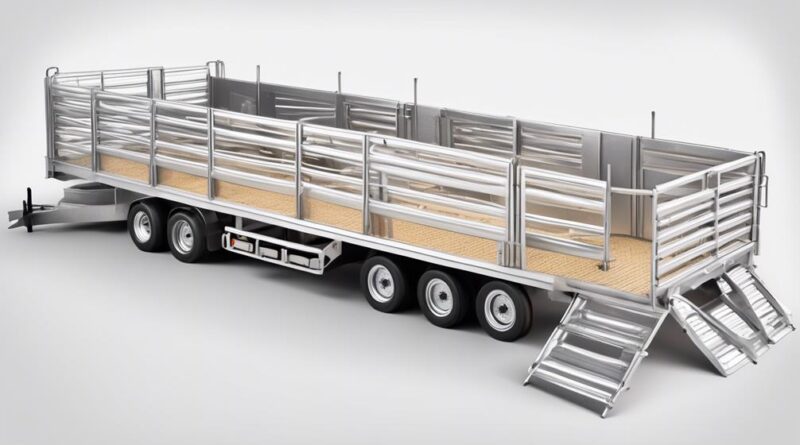12 Tips for Ensuring Cattle Welfare in Transportation and Handling
You might think that ensuring the welfare of cattle during transportation and handling is just common sense, but there are specific tips and techniques that can make a significant difference in the overall well-being of the animals.
From proper loading and unloading techniques to regular health and welfare checks, there are several key factors to consider in order to prioritize the comfort and safety of the cattle.
By following these 12 tips, not only can you improve the welfare of the animals, but you can also enhance the efficiency and safety of the entire process.
Proper Loading and Unloading Techniques
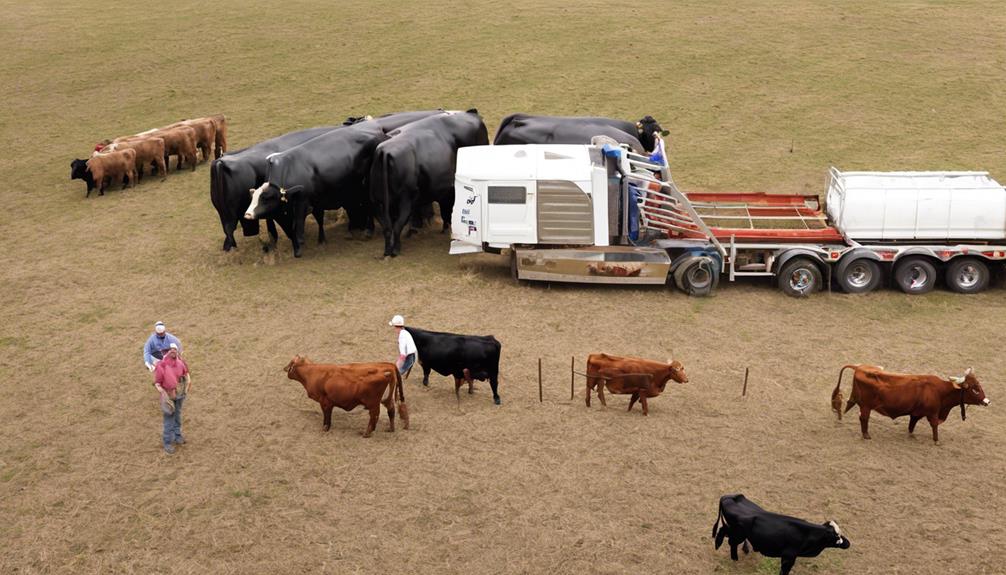
When loading or unloading cattle, ensure that the handling equipment is in good working condition and that the animals are handled with care to minimize stress and potential injuries. Loading efficiency is crucial for the well-being of the animals and the overall transportation process.
Start by ensuring that the loading area is free from any obstacles or potential hazards. This will help in facilitating a smooth and efficient loading process. Ensure that the ramps are secure and have non-slip surfaces to prevent any accidents during loading. Additionally, it's important to have adequately sized holding pens to minimize overcrowding and ensure a calm and orderly movement of the cattle onto the transport vehicles.
Unloading safety is equally important to prevent injuries to the animals and handlers. Upon arrival, carefully assess the unloading area to ensure it's suitable for safely releasing the cattle. The unloading area should be free from any sharp edges, slippery surfaces, or other potential dangers.
When unloading, allow the animals to exit the vehicle at a steady and controlled pace. Avoid rushing the process, as it can agitate the cattle and lead to accidents. Proper unloading techniques also involve using suitable equipment such as ramps and chutes to facilitate a smooth transition from the vehicle to the unloading area.
Adequate Space and Ventilation in Transport Vehicles
Ensure that cattle have sufficient space and proper ventilation inside transport vehicles to minimize stress and ensure their well-being during transportation. Proper space management is crucial to prevent overcrowding, which can lead to injuries and stress. Adequate space allows cattle to stand, lie down, and turn around comfortably. When loading cattle onto transport vehicles, ensure that there's enough space for each animal to move and reposition itself. Additionally, consider the size and weight of the cattle to determine the appropriate space requirements for the journey.
Airflow control is another essential aspect to consider. Proper ventilation helps maintain a comfortable environment for the cattle during transportation. It regulates temperature and reduces the buildup of moisture and noxious gases. Ensure that the transport vehicle has adequate ventilation openings to allow for the exchange of fresh air. Monitor the airflow to prevent drafts that could cause discomfort to the cattle.
During hot weather, ensure that the vehicle is equipped with fans or misters to prevent overheating. Conversely, in cold weather, provide adequate protection from drafts to keep the cattle warm.
Minimizing Stress During Handling and Transportation
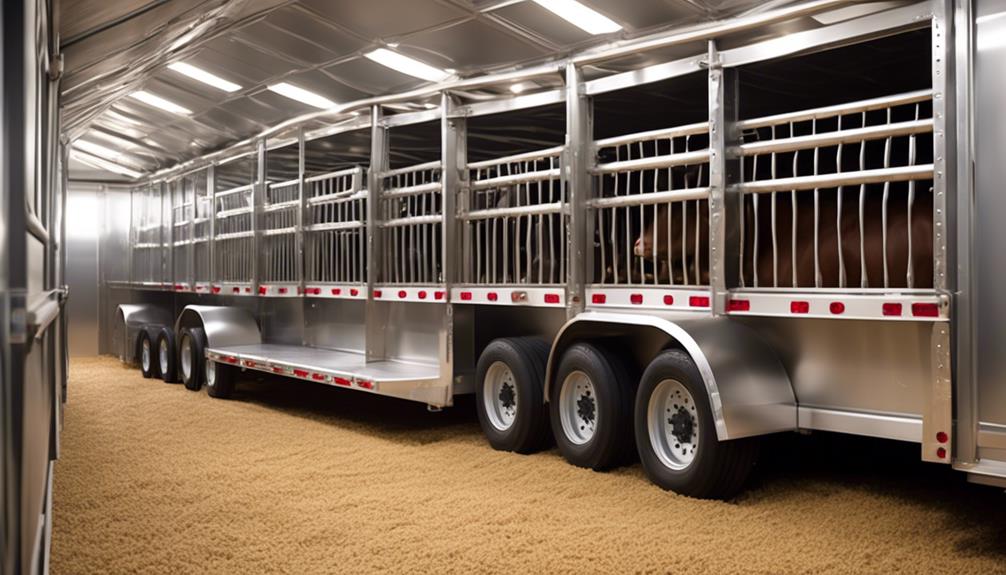
To minimize stress during cattle handling and transportation, prioritize gentle and deliberate movements to create a calm and secure environment for the animals. Reducing anxiety in cattle is crucial for their welfare during transportation. Implementing calming techniques such as avoiding sudden loud noises and abrupt movements can significantly minimize the stress experienced by the animals. When handling cattle, it's important to remain calm and composed, as they can easily pick up on human emotions. Speak softly and move slowly to establish a sense of tranquility and security for the cattle. Additionally, utilizing well-designed handling facilities with non-slip flooring and curved restraints can help prevent injuries and reduce fear in the animals during handling and loading procedures.
Another effective method for minimizing stress during transportation is to ensure that the vehicles used are properly equipped to provide a comfortable and secure environment for the cattle. This includes maintaining adequate ventilation, avoiding overcrowding, and providing sufficient space for the animals to stand, lie down, and access water. Furthermore, minimizing transportation time and scheduling travel during cooler times of the day can help prevent heat stress and reduce overall anxiety in the cattle.
Ensuring Access to Water and Feed
Make sure that cattle have continuous access to water and feed during transportation to support their well-being and minimize stress. Ensuring hydration and providing nutrition are essential for maintaining the welfare of the cattle.
Here are three crucial tips to ensure access to water and feed:
- Regular Stops: Schedule regular stops during transportation to offer cattle the opportunity to drink water and eat. These stops are critical for ensuring that the cattle stay hydrated and nourished throughout the journey. Aim for stops every 4-6 hours, depending on the duration of the trip.
- Proper Equipment: Use appropriate troughs or containers that allow all cattle to access water and feed without competition. Ensure that the equipment is securely attached to prevent spills and wastage, providing a constant supply of fresh water and feed to the animals.
- Monitoring and Adjustment: Assign someone to monitor the cattle during transportation to ensure that they're drinking and eating adequately. Make adjustments as necessary, such as offering different types of feed if some cattle aren't consuming enough or providing additional water if the environmental conditions are particularly hot.
Regular Health and Welfare Checks
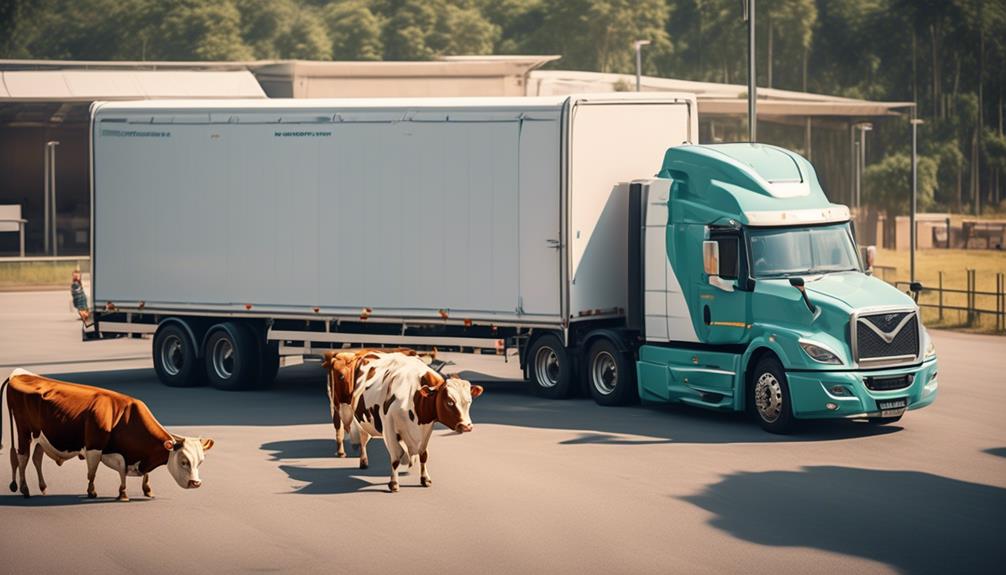
As you continue the journey, regularly check the health and welfare of the cattle to ensure they remain hydrated and nourished, promoting their overall well-being during transportation. Welfare assessment and health monitoring are crucial aspects of maintaining the cattle's welfare during transportation. Conduct regular visual assessments to ensure that the cattle aren't showing signs of distress or injury. Look for any signs of dehydration, such as sunken eyes or dry noses, and take immediate action to provide water if needed. Additionally, monitor their behavior for any signs of illness or discomfort, as early detection is key to preventing further health issues.
In addition to visual assessments, it's important to monitor the cattle's access to water and feed. Regularly check water troughs and ensure they're clean and filled with fresh water. Monitor the feed supply to ensure that the cattle have access to nourishment throughout the journey. Address any issues with water or feed availability promptly to prevent dehydration or malnourishment.
Furthermore, consider the environmental conditions during transportation. Ensure adequate ventilation to prevent heat stress and monitor temperature fluctuations. Take necessary measures to provide a comfortable and safe environment for the cattle.
Regular health and welfare checks not only promote the physical well-being of the cattle but also contribute to their overall comfort and reduced stress during transportation. By staying vigilant and addressing any welfare concerns promptly, you can help ensure a smooth and safe journey for the cattle.
Training for Handlers and Transporters
Handlers and transporters must undergo comprehensive training to ensure the proper handling and transportation of cattle. This is crucial for the welfare of the animals and the safety of the handlers and transporters themselves. Here are three key aspects of training that should be prioritized:
- Handler Competence: Handlers should receive training on cattle behavior, body language, and stress indicators. This knowledge will enable them to understand and anticipate the animals' reactions, allowing for safer and more effective handling. Additionally, training should include proper techniques for moving, loading, and unloading cattle to minimize stress and prevent injuries. This will help handlers to develop the necessary skills to manage cattle in a way that prioritizes their welfare.
- Transporter Certification: Transporters should undergo certification programs that cover topics such as animal welfare regulations, best practices for transporting cattle, and emergency response procedures. This training will ensure that transporters are knowledgeable about the specific needs of cattle during transportation and are equipped to handle unexpected situations effectively. Certification programs also emphasize the importance of providing appropriate ventilation, space, and access to water and feed during transit, promoting the well-being of the animals throughout the journey.
- Continual Education and Evaluation: Training shouldn't be a one-time event. Handlers and transporters should engage in ongoing education and skill assessments to stay updated on best practices and continuously improve their handling and transportation techniques. Regular evaluations can help identify areas for improvement and ensure that handlers and transporters maintain high standards of competence and care.
Implementing Safe Handling Equipment
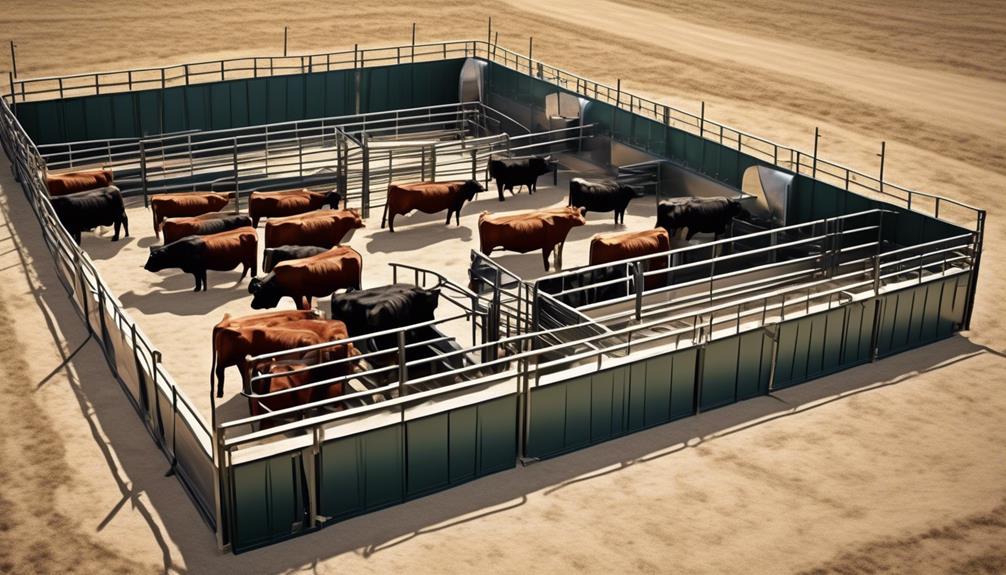
Ensuring the proper handling and transportation of cattle requires the implementation of safe handling equipment to further enhance the welfare of the animals and the safety of personnel involved in the process. When it comes to safe handling equipment, regular maintenance is crucial. Proper equipment maintenance ensures that all tools, such as cattle chutes and sorting gates, are in good working condition, reducing the risk of accidents and injuries to both the cattle and handlers. Regular inspections should be carried out to identify any wear and tear, and immediate repairs should be made to keep the equipment functioning optimally.
Additionally, safe handling equipment plays a significant role in influencing cattle handling behavior. Well-designed equipment can help guide cattle movement in a smooth and controlled manner, reducing stress and potential injuries for both the animals and handlers. The use of well-maintained and appropriate handling tools also promotes positive handling experiences, which can ultimately lead to improved cattle behavior during transportation and handling processes.
It's important to note that the effectiveness of safe handling equipment is closely tied to its maintenance and proper usage. Regular training should be provided to personnel on the correct usage of handling equipment, as this can contribute to the overall safety and welfare of the animals. By ensuring that safe handling equipment is well-maintained and used appropriately, the transportation and handling of cattle can be carried out in a manner that prioritizes the well-being of the animals and the safety of the handlers.
Monitoring and Addressing Injuries or Lameness
Regularly monitor cattle for injuries or signs of lameness to promptly address any welfare concerns during transportation and handling. This is essential for ensuring the well-being of the animals and preventing further complications during transit. Here are some key points to consider when monitoring and addressing injuries or lameness:
- Preventing Lameness: Implement measures to prevent lameness in cattle, such as providing appropriate flooring in transport vehicles to minimize the risk of slips and falls. Additionally, ensure that cattle have access to clean and dry resting areas to reduce the likelihood of hoof problems and lameness. Regular hoof trimming and maintenance can also help prevent lameness and related injuries.
- Regular Evaluation: Conduct regular visual assessments of the cattle to identify any signs of injury or lameness. Look for indications of discomfort, such as favoring a particular limb, reluctance to move, or changes in gait. Promptly address any concerns by involving a veterinarian or experienced livestock handler to assess the situation and provide necessary care.
- Injury Management: Develop a plan for managing injuries that may occur during transportation or handling. This includes having appropriate first aid supplies readily available and training personnel in proper injury management techniques. Establish protocols for separating injured cattle from the rest of the herd to prevent further stress or injury, and provide appropriate veterinary care as needed.
Frequently Asked Questions
How Can Cattle Welfare During Transportation Be Affected by Weather Conditions?
Weather conditions can significantly impact cattle welfare during transportation. Temperature and humidity levels can affect their comfort and stress levels. Wind and rain can also increase the challenges of cattle transportation, requiring careful planning and preparation for their well-being.
What Are Some Common Signs of Stress in Cattle During Transportation and Handling?
You'll notice signs of stress in cattle during transportation and handling, such as excessive vocalization, restlessness, and reluctance to move. Employ proper handling techniques to minimize stress and ensure the welfare of the animals.
Are There Specific Regulations or Guidelines for the Maximum Travel Time for Cattle Transportation?
Yes, there are specific regulations and guidelines for the maximum travel time for cattle transportation. These regulations ensure the welfare of the animals during transportation and handling, addressing their needs and minimizing stress.
What Are Some Potential Risks or Challenges to Cattle Welfare During Long-Distance Transportation?
During long-distance transportation, potential stressors like extreme temperatures and overcrowding can affect cattle welfare. Monitoring their health and observing behavioral indicators, such as signs of distress, are crucial in ensuring their well-being.
How Can the Design of Transport Vehicles Impact Cattle Welfare During Transportation?
Consider the impact of vehicle design on cattle welfare during transportation. Ensure animal comfort with proper ventilation, non-slip flooring, and space allowance. Reduce stress by managing behavior and minimizing noise and vibration.
Conclusion
In conclusion, ensuring the welfare of cattle during transportation and handling is crucial for their well-being and the quality of their meat. By following these 12 tips, you can minimize stress, injuries, and health issues, and ensure that cattle are transported and handled in a safe and humane manner.
It's important to prioritize their welfare at every step of the process to ensure that they arrive at their destination in good condition.
